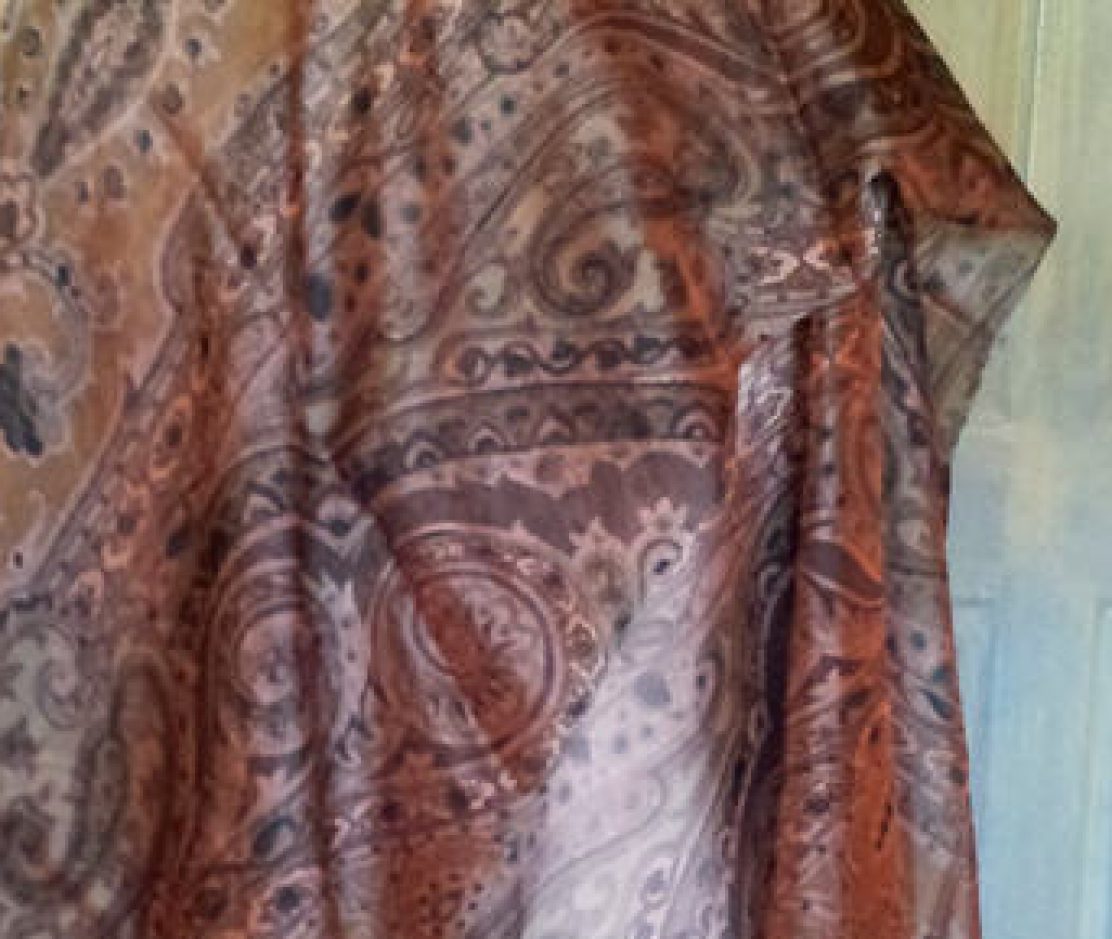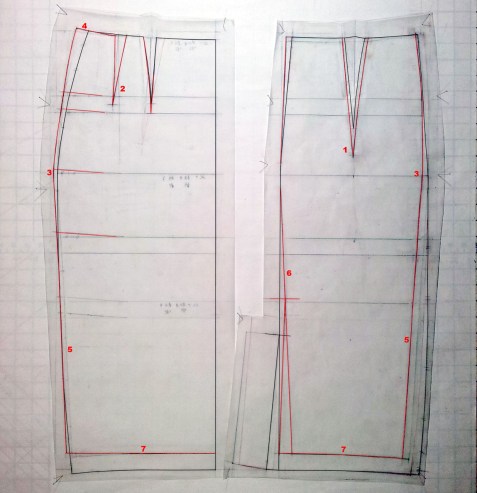If only it were the height of summer instead of chilly winter here…So even though my bodice slopers are done, I can’t really put them to good use. Boo. I haven’t got sleeve slopers to make them practical for winter. And sleeves sound like they’d be a royal pain to draft and fit.
So what do I do? Move on to a pencil skirt sloper of course. I mean, how difficult can they be to fit right? Well, maybe just a tiny bit if you’re fussy not only about the wrinkles, but also about any potential frump factor. I like my pencil skirts fashionlicious, not corporate teamaker ready.
Since I had fairly good success with Kenneth King’s bodice moulage, and saw the success Clio had with her Kenneth King pencil skirt, I decided to start with Mr King’s Skirt draft instructions. Here are the results based on following the instruction strictly:
Hmm…They may be the instruction taught by the Parisian couture pattern drafting system, but my result looks a tad frumpy to me. That’s the thing isn’t it, there are all sorts of experts and systems out there. But you just don’t know if their vision of loveliness is to your taste or not. And we also know that taste and trends change. So are the instructions from the various pattern-drafting camps up to date with current trends? Do all those couture dissecting books examine current couture and not just past examples?

Dennic Chunman Lo talks about a designer’s signature fit in his Patternmaking book, how clothing aimed at mass market may have a different cut to those at higher price designer end (and how nowadays jacket shoulders have a lot less ease / shoulder extension than before). Maybe some of the industry experts instruction are geared towards designs for a different audience than you.
Of course it could simply be that my figure isn’t suited to pencil skirts and no amount of tweaking is going to fix that. Maybe they only look fab on stick insect models or curvy goddesses. Also, have you notice a lot of these skirts are shown with legs crossed or slightly apart? Maybe at attention stance doesn’t show off these skirt well. (And I don’t know why some people call untapered skirts pencil skirts. To me they’re just straight skirts. I mean pencils have tapered points, right? You can’t write with them otherwise. Why call them pencil skirts if they’re not similarly tapered???)
Anyway, long story short, I tried tweaking the muslin to my taste. I want a more noticeable tapering at the hemline. And a bottom hugging back.
What can I say, I have booty envy. Mine are a bit flat. So I’m unable to fill out normal cuts like some of you can. I’m not sure how one would achieve this. Can you just taper more at the back side seams? Have anyone tried that? Does it cause weird twisting of the side seams or rippling in the stitching (due to difference in degrees of bias between the front side seam and the back side seam)?
I checked out a few high street shops and noticed some pencil skirts seem to taper on CB seam as well as the side seams. I’ve never seen this in commercial patterns and pattern-drafting book. Have you?
My last resort would be to add back princess lines and use them to add more tapering to the back. I’ve done this before with previous pencil skirts, some of which were perhaps a bit too tapered – making going to the bathroom a bit troublesome, especially in dresses with such over-tapered skirts!
That reminds me I need to be careful that I don’t over do the tapering so that it’s hard to walk / sit / climb the stairs in, or go to the loo! (Note to self: must test drive the final muslin like Clio does.) That’s another gripe I have with existing pattern-drafting / fitting instructions – they may tell you how to add ease, but not why that much or why add it there. Not knowing the principles makes it impossible to adjust the instruction to update or personalize the fit.
That’s why I’ve ordered the reprint of Theory of Garment-Pattern Making by W. H. Hulme from the 1950s. It supposedly covers things like the effect of anatomy, proportion, and movement on garment design and pattern drafting. I’m hoping it’ll answer my question about what ease is really necessary where. Here’s Fashion Incubator’s review of the book.
In the meanwhile I tried the following changes:
- Increased the dart depths and made side curve above the hip shallower to match my bodice moulage.
- In the front I split the deeper dart depth into two darts per side. When I tried one deeper dart, it points right at the hollow between my tummy and my protruding thigh, so looked wrong. Splitting into two allows me to have one dart accommodate my tummy and the other my protruding hipbone.
- Moved almost all the hip ease to the front so that the back would hopefully hug my bottom better and the front accommodate my protruding thigh and forward limb movement (walking, sitting).
 Added the front ease for protruding thigh using the technique shown in Fitting and Pattern Alteration. The slight tilting up at the side seam seems like it might also push the ease forward rather than side-way and make the front view slimmer looking. I think the side-way expansion of the standard draft doesn’t skim my front-back body well, so makes the skirt look slightly too big and therefore frumpy.
Added the front ease for protruding thigh using the technique shown in Fitting and Pattern Alteration. The slight tilting up at the side seam seems like it might also push the ease forward rather than side-way and make the front view slimmer looking. I think the side-way expansion of the standard draft doesn’t skim my front-back body well, so makes the skirt look slightly too big and therefore frumpy.- Straighten the side tapering (the original draft has slight curve) and made back side seam match the front side seam angle (for some reason, my original draft based on the calculation instruction came out with less tapering on the back vs the front).
- Tried tapering a little bit at CB below the hip as well. Above the hip I made the tapering less deep so it’d match my bodice moulage. Why? Oh, I don’t really know. Maybe “why mess with a moulage that seems to fit”?
- Shortened the skirt about 1″. I would never understand guidelines that recommend the same length for everyone.
Here’s the result:
I hope I’m not deluding myself here. I think the changes does make the skirt look smarter, more like how pencil skirts look on all you gorgeous gals. Short of getting booty boosting Spanx I think this will be as close as I’m going to get to a practical yet flattering pencil skirt without the princess seams. I might still add princess seams occasionally for a even more tapered look on some skirts. But for dresses this will definitely be as tapered as I’m going to go unless the fabric has more stretch.
Now should I try this out in a bog standard corporate wool? Or should I go for variations in some funkier fabrics? I already have three fabrics lined up for this silhouette, if not exactly this bog standard boring darts+CB vent pattern.
















I gave up on that a while ago as I wasn’t happy with my dowdy looking results. Yours look awesome.
I agree that princess seams in the back would give you the advantage of shaping it more as well as offering you additional walking room options in the form of hemline vents/slits. That said, what you’ve tweaked has a nice result! Pencil skirts are a big tricky in terms of proportion, I find, so perhaps playing with the length and inch here or there may make a difference, too. Love your fabric plans!
Thanks! I’m hoping with proper skirt weight fabric it’ll hang even better. The thin muslin has a knack for sticking out where you don’t want it to.
Before I finalize the pencil skirt block I’m also going to try the princess seams, see how much I can take out and still sit and walk. And also different lengths. Would be great to have a full set of blocks to speed up designs / projects!